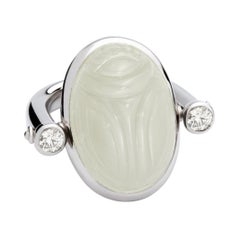18 K Gold Moonstone Bracelet
Recent Sales
2010s German Egyptian Revival Cocktail Rings
Diamond, Moonstone, 18k Gold, White Gold
18 K Gold Moonstone Bracelet For Sale on 1stDibs
How Much is a 18 K Gold Moonstone Bracelet?
Colleen B. Rosenblat for sale on 1stDibs
Colleen B. Rosenblat believes that “it is not we who select the jewelry, but the jewelry that selects us.” Based in Hamburg, Germany, she is known for her contemporary pieces that feature unconventional color and form along with fine materials like pearls, precious gemstones and gold and silver.
When she was a child, Rosenblat stumbled across some smoky quartz in the forest. It ignited a passion for gemology and jewelry that took her around the world. As a teenager, she used a handful of jewelry-making tools borrowed from a friend to craft her own pieces out of silver.
Trips to Australian and Indonesian gemstone mines solidified her focus, and Rosenblat applied to study at the Gemology Institute of America in Los Angeles. After graduation, she studied in Idar-Oberstein in Germany, finished a goldsmith apprenticeship in Frankfurt and earned a jewelry design diploma from Parsons School of Design in New York. She then split her time between the United States and Germany, working as a freelance goldsmith for several years before opening her own workshop and award-winning showroom in Hamburg.
Designed by American architect and interior designer Michael Gabellini, Rosenblat’s showroom luxuriously presents her jewelry. Handmade furniture by American woodworker George Nakashima complements the interior. In 2000, the American Institute of Architects in Philadelphia awarded it the Institute Honor Award for Interior Architecture.
Rosenblat continues to produce exquisite jewelry under her brand. Her work has been featured in high-end fashion magazines such as Vogue, Elle, Harper’s Bazaar, Vanity Fair, InStyle and GQ.
On 1stDibs, find a collection of Colleen B. Rosenblat rings, earrings, necklaces and more.
Finding the Right cocktail-rings for You
A flashy symbol of wealth during the early 20th century, antique and vintage cocktail rings have gained broader appeal in the decades since for the hefty dose of glamour they bring to any ensemble.
Cocktail rings earned their name for their frequent appearances during glitzy cocktail parties at the height of the Prohibition era. Back then, these accessories were seen not only as statement pieces but as statements in and of themselves. They openly represented a sense of freedom and independence as well as a demonstration of opulence. After all, the 1920s heralded the Harlem Renaissance and Art Deco design, and a slew of social and cultural shifts meant that women in particular were breaking from pre–World War I conventions and embracing newfound freedoms to express themselves as individuals.
Women expressly wore cocktail rings on the fingers of their right hand versus the left, which was “reserved” for an engagement ring or wedding band, accessories definitely paid for by a suitor. And for cocktail rings, the bigger the colored gem at the center — which is usually mounted in a high setting — and the more elaborate the design, the stronger the likelihood of being noticed.
Cocktail rings remained a popular piece of jewelry for women until the 1930s, when the Great Depression and the onset of war marked a change in behaviors nationwide. While the 1960s and ’70s saw a return in visibility for the accessory, it wasn’t until the 1980s that cocktail rings once again assumed their position as a beacon of luxury and glitz.
During the 20th century, the range of dazzling cocktail rings seems to have been limitless, from glimmering gold rings set with carved jade diamonds designed by David Webb to Pomellato’s pink quartz confections to striking Gucci butterfly rings with accent diamonds set in a pavé fashion.
So, how do you wear a cocktail ring? Cocktail rings “can be worn for almost anything — dinners, date nights, parties, special events, on the red carpet,” explains David Joseph of New York-based jewelry brand Bochic.
Can you wear cocktail rings with other rings? “In my opinion, cocktail rings should stand on their own since they showcase a large gem in the center,” says Joseph.
These glamorous jewels can be worn inside or outside crowded taverns, in either daytime or nighttime with casual or dressy attire. On 1stDibs, find a wide variety of antique and vintage cocktail rings, including those offered by Chanel, whose elegant cocktail rings often feature pearls and, of course, diamonds, and sometimes were styled after showy flowers like the camellia, and Van Cleef & Arpels, whose detailed and intricate designs are viewed as miniature pieces of wearable art.
